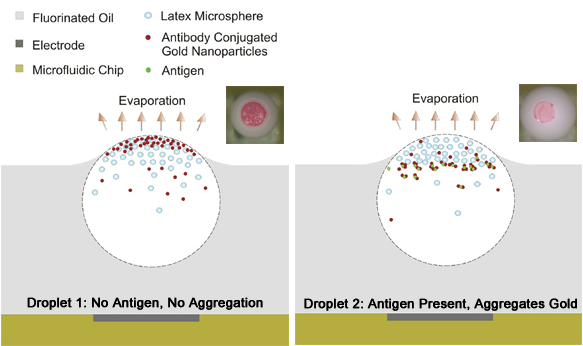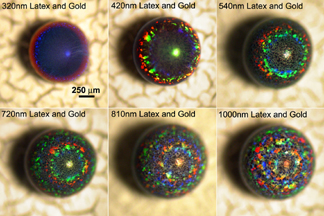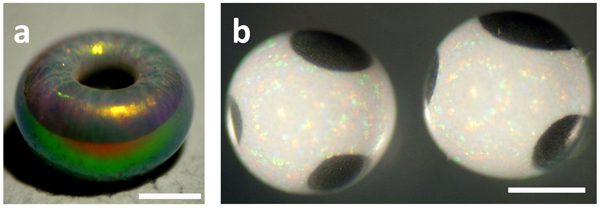Vinayak Rastogi
| PhD, Chemical Engineering, 2010 North Carolina State University M.S., Chemical Engineering, 2006 North Carolina State University B.Tech., Chemical Engineering, 2002 Indian Institute of Technology, Roorkee, India Curriculum Vitae |  |
Research Focus: Microdroplet Engineering for Microbioassay and Synthesis of Functional Structured Porous Particles
Microdroplet Bioassays
This project is aimed at developing quantitative micro-bioassays which need only microliter volumes of analyte for biomoleculer detection. Latex agglutination assays have been used so far as the tools for immunodetection. The disadvantages of these tests are that they require large amounts of sample, have ineffective optical detection, are hard to miniaturize and do not give simple electronic readouts. We use a novel microfluidic system developed by our group to manipulate microliter volume droplets to overcome the disadvantages of current immunodetection techniques. The liquid droplets float on the surface of high density oil and can be moved around using dielectrophoretic force. The evaporation rate of the droplets is controlled using a small humidity chamber. Due to evaporation, convective flow is established within the droplets and the dispersed colloidal particles collect on the surface of droplet exposed to the air. Depending upon the aggregation state of the biomolecules in the droplet, different visible patterns are obtained.

Figure 1: 1 µL droplets with different concentration of analyte.
Using these bioassays multiple immunodetection tests can be carried out on a single chip using only nano-liter volumes of the sample. We are currently developing a automatic microfluidic system where a large droplet containing the analyte can be broken into smaller droplets of controlled volume and then moved onto the oil surface for immunodetection with multiple detectors.
Microstructured Supraparticle Synthesis
The goal of this project was to synthesize light-diffracting assemblies using sessile droplet templates on a superhydrophobic surfaces. Aqueous suspension droplets assume spherical shape when dispensed on superhydrophobic substrates. We used such drying sessile droplets as templates for assembling latex microspheres and gold nanoparticles into closed packed structures due to restricted free volume. Spherical opals of 1 – 2 mm in size could be easily produced within an hour in large quantities by this very simple and efficient process. Upon illumination with collimated light, the dried spherical supraparticles display discrete colored rings created by the periodic arrangement of latex particles in the surface layer. The physical origin of the colored patterns and the relationship between the size of colored rings generated by incident light, corresponding wavelength and nanoparticle size were characterized. We found that ring size decreases as the latex particle diameter in the opals increases. This trend is quantified using Bragg’s law of diffraction. Patterning of the substrates and controlled pinning of the droplet templates allows synthesizing nanoparticle assemblies of more complex shape and composition.


Figure 2: The attached figure shows supraparticles (left – latex only, right – latex and gold nanoparticles) exhibiting ring like diffraction patterns when exposed to collimated light.
Anisotropic Supraparticle Synthesis
The project involves using droplet templates dispensed on superhydrophobic substrates for the fabrication of a new class of anisotropic particles. We produced both shape-anisotropic and composition-anisotropic supraparticles. The shape anisotropy was demonstrated by fabricating “doughnut” assemblies using droplets of both pure silica suspensions and silica mixed with gold nanoparticles. The composition anisotropy was realized by redistribution of the magnetic nanoparticles in droplets containing mixtures of latex and magnetic particle suspensions. The redistribution is dictated by the pattern of magnetic field to which the droplet templates are introduced during drying. We developed new types of patchy magnetic particles that can find application in targeted drug delivery. The latex matrix can be infused with a drug and the magnetic patch(es) facilitate remote manipulation of the carrier.

Figure 3: (a) Angled view of a doughnut supraparticle, (b) Tri-patch (mickey mouse) magnetic supraparticles. Scale bars are 500 µm.
Publications
